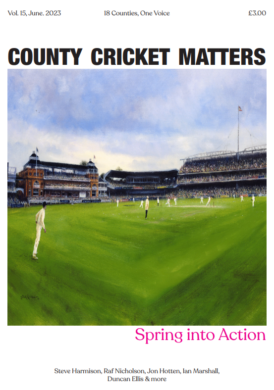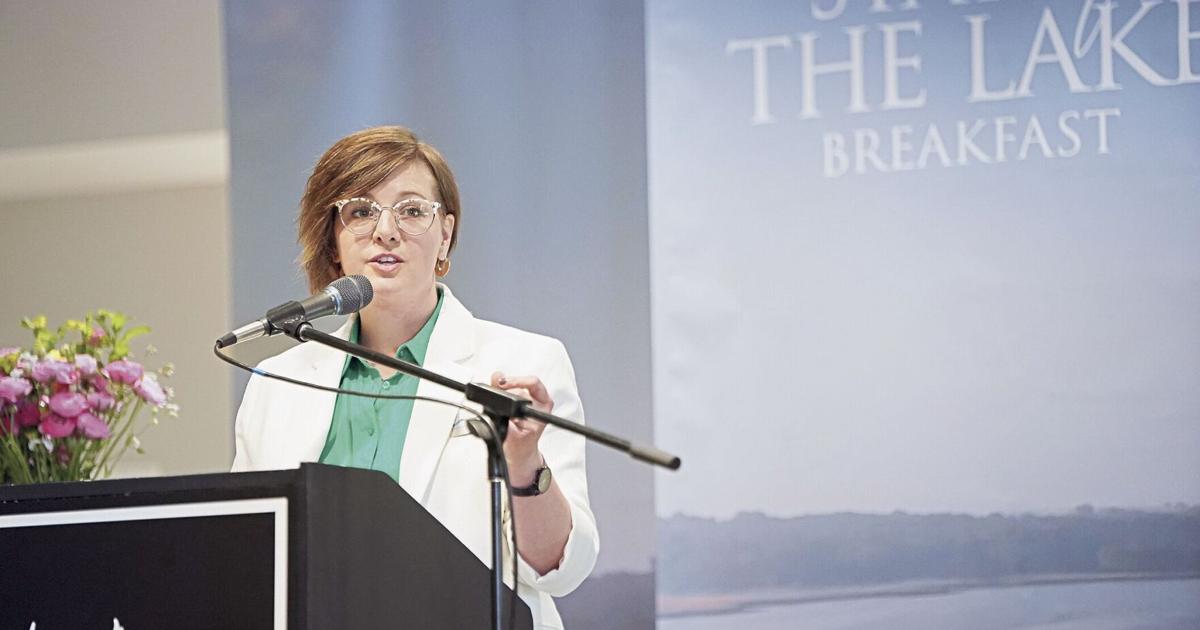County Cricket Matters Issue 15

Martin Chandler |
Published: 2023
Pages: 38
Author: Chave, Annie (Editor)
Publisher: County Cricket Matters
Rating: 5 stars

Not for the first time the cover of Issue 15 of County Cricket Matters is graced by a piece of artwork from former England wicketkeeper Jack Russell. It is an absolutely beauty, so much so that I feel bound to express the view that henceforth the front cover should always be Jack’s domain. There is something about the man and his work that perfectly captures the essence of the game.
So in my opinion CCM 15 is worth buying for the cover alone, but I am pleased to be able to confirm that the contents are well up to the now expected five star standard that has been set in the past, particularly to the bibliophiles amongst us. I suspect that the appearance of a number of contributions on the subjects of books and bookishness is simply the luck of the draw rather than the start of a trend, but I will be more than happy if it is the latter.
The first bibliographical piece is a contribution from Jon Hotten, the man who pens the book reviews for Wisden Cricket Monthly, although his most enduring contribution to the literature of the game will be the subject of his piece here, his collaboration with Yorkshire’s favourite Knight, the superb Being Geoffrey Boycott.
But that is by no means all. The editor herself reviews a lesser known book from last year, David Collins’ Iconic Elevens, and Sussex supporter David Harrison writes about My Cricket Library, a subject always worth writing or talking about.
And then there is Cricket’s Forth Bridge, a very clever title for what is an interview between Deputy Editor Jeremy Lonsdale and Hugh Chevallier who, whilst he may not have the more glamorous title of Editor, I have always been under the impression has been the driving force behind Wisden Cricketers’ Almanack for the last quarter of a century.
This is a skilfully done interview. Those of us who buy the book every year are voracious consumers of trivia and background information about Wisden and I wasn’t entirely convinced I would learn a great deal from the interview. I need not have been concerned though, as Jeremy’s skilful choice of questions makes the conversation he transcribes a fascinating one.
Moving on to the remainder of CCM15 it begins with Annie’s succinct editorial. She has a priceless ability to combine a summary of issues that are, on the whole, rather depressing for those of us who love the county game, with an upbeat message. As ever she sets the scene very well before moving on to her own interview.
Steve Harmison in his pomp was a sight to behold, and he is a man whose views on the subject of cricket in Durham are illuminating. Harmy’s love for his home town is legendary, and his perspective on both county and country are well worth reading.
There isn’t much history on show in CCM15, making way on this occasion for the bibliography, but John Stone does take on a rather tricky mission. In terms of the one innings in the history of county cricket that has been written about most a leading candidate must be Harold Gimblett’s famous debut century for Somerset against Essex at Frome in 1935.
The problem those revisiting it now are faced with is that the story was told by Ralph Barker, in his 1967 book Ten Great Innings, in a way that makes that, probably, my favourite piece of cricket writing ever. Even David Foot, in his superb biography of Gimblett is unable to match the quality of Barker’s account.
Yet still John decides to take the task on and to be fair to him does it very well. He has clearly and wisely eschewed a simple retelling of the story, and has introduced a few digressions that make his account an enjoyable one, even for those of us who have read Barker and Foot on the same subject.
Raf Nicholson has written the article that I found the most thought provoking in CCM15, and as a result I do feel able to make the confession that I don’t watch a great deal of women’s cricket. I realise now that that is not because I am a dinosaur, but simply because I much prefer red ball cricket to white ball, and if the latter is all that is on the menu then then it needs to be between proper teams such as counties or countries rather than contrived franchise or regional sides.
On the subject of white ball cricket Joel Lamy contributes an article in praise of the Blast which, I have to agree, if you have to have T20 cricket that is not between Test playing countries, is by far the best way to receive it. The main thrust of his contribution is to, nonetheless, suggest eleven ways in which the Blast could be improved, all of which are sensible and a number of which had never occurred to me.
Ian Marshall, the editor of the long running Playfair annual, writes about the Unsung Heroes of County Cricket. There are of course many of those, and almost by definition anyone involved with CCM fits the description, but Ian concentrates on three men in particular; scorer Tony Kingston at Northants, photographer David Griffin at Derby, and general factotum (but in particular a fine writer) Ken Grime from Lancashire.
On the subject of Lancashire, and there are few better subjects, Garry Clarke bemoans the county’s seeming abandonment of the Aigburth ground in Liverpool.
But what of the future of the game? Ron Martin looks at the existential threat to cricket as we know it that the prospect of year round franchise contracts for players brings. Duncan Ellis explains how the ECB can broaden the appeal of the game in the UK. Most interesting of all however is Paul Bird’s explanation of why, on the basis of economic theory, all CCM readers’ knee jerk reaction to The Hundred is the correct one.
Which just leaves two contributions to mention. The first is certainly an eclectic one, explaining the concept of Clock Cricket, a version of the game that has much to commend it. Played indoors and whilst sat down it really can be played by anyone, including the elderly and infirm. It gives me the prospect of being able to play the game in my dotage, which would certainly be simpler for that time of my life than my current plan, which had been to catch up on all the fiendish crosswords that grace the back covers of CCM, not one of which I have yet got close to completing.













